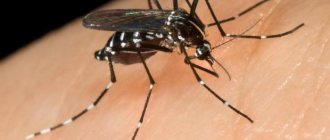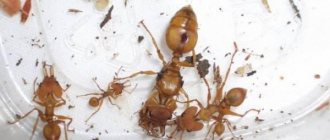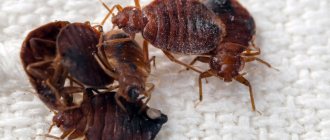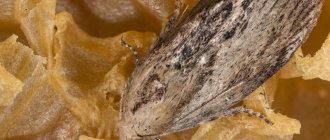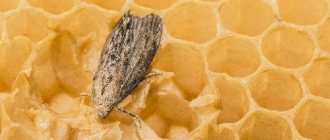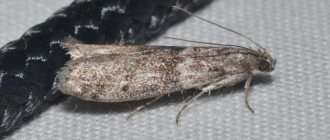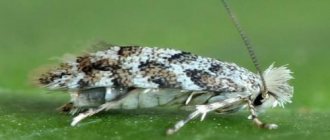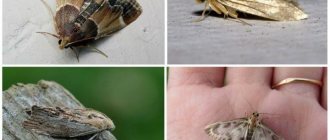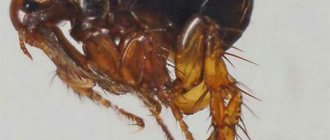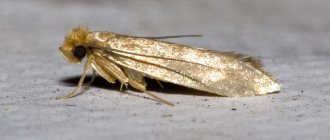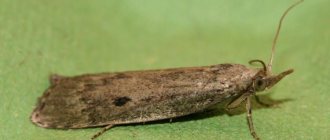The most important thing is what kind of moth is in the house, what type it belongs to - there are clothes moths and food moths. These pests, similar to each other, but completely different in their biology, each enter the house in their own ways.
Important!
When wondering where moths come from in an apartment, it is useful to remember that they do not care about the sanitary condition of the room. The pest equally effectively infects unhygienic barracks and luxury housing. The main thing for her is the availability of food supply, and it is this food supply that is most abundant in expensive houses.
What is
A moth is an insect belonging to the order of butterflies. The size and appearance of an individual depends on its species. House moths usually include clothes moths, furniture moths, grain moths and food moths. All of their adult representatives are small in size (up to 15 mm) and unsightly in color, for example, gray-green, dirty brown. The insect lives not only indoors, but also in nature. For example, there are cabbage, apple, and rye moths.
The feeding method of individuals also varies greatly. All larvae and caterpillars, thanks to their powerful mouthparts, can eat tough and hard food: stems and leaves, nuts, cereals, cabbage, beets. All moth species have their own favorite food, and it is often reflected in the name of the species. In addition, in some varieties, the adult does not have a mouthpart and cannot feed, and therefore lives no more than a week.
These pests live near or directly in a food source, for example, in cereals, cabbage, or on an apple tree. At first, a small nest always appears, where all the larvae live compactly. Nests are also within reach of food.
Pest varieties
The most common:
- Food. There are several types of it. They differ from each other in the products in which they prefer to reproduce . They have some external differences in the color of the wings: the grain moth is off-white, the flour moth has a black-brown pattern, and the granary moth is black-orange. The length of the wings in all individuals does not exceed 10 mm. The larvae are transparent white, at 6 weeks of age they reach 1.5-2 mm and begin to pupate.
- Clothes. Smaller, reaching no more than 3 mm in length. There is no pattern on her wings; they are light brown. The larvae are yellowish in color with a brown head.
- Furniture. Similar to the previous species, but the size of adults reaches 8 mm. The coloring is slightly darker and the larvae are white. It is distinguished by a well-developed jaw apparatus, providing the necessary pressure for eating dense food. Has a large intestine and stomach.
- Cabbage. The gray color makes it inconspicuous. There is a light pattern on the wings. This color allows for good camouflage. These insects are larger in size than house moths . The duration of maturation of the larvae in the egg is 72 hours. The caterpillars are 12 mm long and green in color. First they live in the lower part of the leaf, and then crawl to its upper part, where they create a cocoon. During the maturation period, 4 moults occur.
- Poplar. It has an inconspicuous appearance, its length is up to 7 mm. There is fringe on the hind wings. It enters the house through open windows. The maturation of the larvae lasts 2-3 weeks, they have a yellowish tint.
- Potato. They are distinguished by a grayish-brown tint. The wings have a pattern of brownish-yellow stripes and spots, the edges indicated by dark lines. The fringe on the hind wings larger than the wings themselves. The length of insects is 10-16 mm. The larva reaches 10-12 mm, it is almost completely transparent. Its color depends on its diet: the one that feeds on leaves becomes green, and the one that feeds on tubers becomes pale gray.
- Wax. Quite large, reaching 20 mm, while males are smaller than females. At rest, females fold their wings and males spread them. The period of egg development is 10 days. As the caterpillar matures, it molts 10 times.
The food moth is an insect for which your kitchen can become its habitat.
Causes of infestation of premises with food moths
It is unlikely that you will be able to completely insure yourself against the appearance of food moths in your apartment, because to infect the kitchen, one larva that has flown into an individual or one larva in packaged cereal is enough. It is much more important to create conditions at home that will not allow moths to comfortably multiply and spoil food.
First, let's see what conditions are most favorable for food moths:
- Feed. Without food, the moth simply cannot reproduce, so it always needs a source of food: boxes of cereal, bags of flour and nuts, or at least dried herbs.
- Convenient place to live. The moth prefers lockable kitchen cabinets and pantries, where it can live and feed at the same time. It is almost impossible to detect food moths on open kitchen shelves - they avoid light.
- Lack of ventilation and twilight. The moth does not tolerate fresh air and direct sunlight, preferring enclosed spaces where food is stored.
- No pungent odors. There are aromas that moths find very unpleasant and cause them to move away from their source. These include the smell of citrus fruits, lavender, eucalyptus, tobacco, vinegar.
Activity of moth butterflies in spring
One day early in spring, many moth butterflies appeared in our Moscow apartment. They sat on a variety of places (walls, doors, window sills and window frames). Butterflies from time to time flew from place to place to our “stormy applause,” with which we did not greet the moth at all, but tried to slam it down.
I called the sanitary and epidemiological station and asked what was happening? The employee who answered the phone clearly explained to me that I had to do well in school and know that a moth is just a butterfly. And in the spring the butterflies begin to fly. And not every moth gnaws holes in fabrics or spoils fur coats and food. And it’s not moths who do this, but caterpillars. And then she asked a rhetorical question: “Did you plant poplars under the windows? So what do you want? It was clear from her irritated tone that I was not the first to call that day about the mass appearance of moths. Fortunately, I never encountered so many flying moths again. But a short educational course on the topic of moths turned out to be very useful.
How to fight
You can get rid of moths at home only by finding their lair and destroying all the eggs and larvae. In addition, the butterflies will need to be destroyed so that they cannot lay new eggs. For these purposes, it is necessary to use all possible methods of control, namely: chemical, physical and folk methods. Of course, chemicals are always more effective, so you need to start with them.
Chemicals
Modern insecticides will help remove these pests. They are available in the form of aerosols, fumigators and sections. The first act quickly, the second - slowly, but protect better, the third - only protect.
Aerosols.
The use of aerosols in the fight against moths is very labor-intensive. To completely destroy these pests, you need to spray not only infected items, but also all surfaces in closets, carpets, and upholstery. One can will not be enough for this. After treatment, 3-4 hours later, you will need to thoroughly wash the room, ventilate it and wash the disinfected items.
The use of aerosols against kitchen moths is completely limited. They can be used to poison flying species, including butterflies. But the use of aerosols against larvae in cereals and food storage areas is prohibited, since the products will be poisoned and unsuitable for consumption in this case.
The best aerosols are:
- "Armol".
Ideal for fur and wool products. Smells like lavender. It costs about 70 rubles. - "Raptor".
Effectively destroys insects at all stages of its development. Smells like lavender. The residual effect lasts up to a year. A bottle will cost 90 rubles. - Mosquitall "Protection against moths".
A very powerful product with a lavender scent. Suitable for processing fabrics, furniture and clothing. 200 ml of the drug costs about 100 rubles. - "Clean house".
Like other aerosols, it is highly effective and has a lavender scent. In addition, “Clean House” is used very economically.
Fumigators.
To combat moths, they are used much less frequently than aerosols. However, using them is very simple: you need to place a plate or flask with liquid in the device and plug the device into a power outlet. When heated, it begins to emit an odor that is detrimental to the insect. This aroma does not bother a person at all and is even imperceptible to him.
For baiting moths, the same fumigators are suitable as for mosquitoes:
- "DiK-3".
This device costs about 30 rubles and effectively copes with pests. Suitable for fighting kitchen and clothes moths, however, you should not place it near food. - "Raid".
An analogue of the DiK-3 device, but its cost is many times higher - 120 rubles for the device and 10 plates for it. - "Mosquitall".
Like other fumigators, this device is equally effective against moths and mosquitoes. Its action is enough for a room of 30 square meters. m.
Mothproof sections.
This type of chemicals against these pests is also in demand. Their action is aimed at scaring away butterflies, however, the larvae that have settled nearby remain safe and sound. Therefore, the use of this remedy is more of a preventative measure than a control method.
- "Raptor".
Sections of this brand are very common among buyers. Their aroma is different. For proper protection, you need to hang 2 sections per cabinet. Their effectiveness period is estimated at 4 months. - "Mosquitall".
These sections come in two types: plates or bags hung on a hanger, or blocks glued to the surface of the cabinet. Their cost varies from 50 to 120 rubles.
Physical means
You can destroy moths without using chemicals, namely:
- To begin with, you should always find the insect nest and remove it, for example, vacuum the shelves.
- For butterflies, fly-catching tape should be used.
- If there are moths in the cereal, you can bake it in the oven for 30 minutes at 60 degrees.
Folk recipes
Moths, like other insect pests, cannot tolerate the odors of certain plants. These include lavender, citrus fruits, tobacco, and geranium. Using these herbs, you can scare it away for a long time. Among the means available to a person at home that can destroy moths is naphthalene. However, recently its use at home is not recommended.
A universal method of prevention
There is one universal folk recipe for getting rid of moths in an apartment. But it rather prevents the appearance of the pest than actually destroys it.
- Dried lavender, tobacco, and citrus peels are placed in a small bag made of thin fabric, or preferably gauze.
- It is then placed in a closet with clothes or food.
- The contents of the bag should be changed once a month as the smell fades.
Calling specialists
Unlike ordinary people, only professionals know how to get rid of moths quickly and effectively. In addition, they always provide a long-term guarantee on their services. It is recommended to contact the parasite control service for those who do not have the time and desire to fight on their own, or the infestation is too strong. Specialists will competently select the product and carry out thorough processing.
How long does he live?
How long does a moth live? Its lifespan is considered an important indicator, because these types of butterflies actively eat clothing and furniture.
Before the onset of puberty, this parasite goes through 2 stages of development: egg and larva. At an ambient temperature of 20 degrees Celsius, 1 egg of such a moth takes 14 days to develop.
The development period of 1 larva is 3–9 months. At this time, the larvae of this parasite envelop themselves in a special cocoon, in which they develop in the future.
After the larva has formed into an adult and has wings, the new moth lives for a maximum of 30 days.
This period may be shorter depending on the type of butterfly.
If we sum up the above 3 time periods of development of this parasite, we get a very long period during which this pest does not destroy specific items from the wardrobe or furniture.
How many days does 1 such moth live? The duration of its life cycle is ultimately 30–60 days, of which the insect lives in the form of a butterfly for up to 14 days. The full development cycle from egg to the formation of an adult of such a parasite is 60 days - 2-3 years.
How long can a moth live without eating any grocery food or other food? Without food, its caterpillars can live a maximum of 30 days.
How long an adult moth lives depends on its species and gender. Females live 7–10 days, and the lifespan of a male is 30 days.
How clothes moths get into an apartment
So, where do moths come from in the closet if all things are new, clean and neatly folded? To find out, you should remember whether you purchased the following products recently:
- natural wool carpets
- furniture with natural upholstery
- outerwear made of fur or wool
- wearable woolen or knitted items
- shoes with natural fur.
It is also useful to read: Why does a moth lack a proboscis - isn’t it a butterfly?
If moths appeared at home after one of these purchases, then we can say with confidence that the larvae were already in it at the time of purchase. After settling in, the moth began to multiply and spoil other things that came in its path. Unfortunately, the pest can even be in expensive items from trusted stores that protect their reputation.
Store-bought or used furniture can also serve as an excellent “vehicle” for transporting moth larvae to a new place of residence. This is especially true for old furniture, in which it is very easy to get to the “tasty” filler.
Clothes moths can choose a more exotic way of entering the house - on the fur of pets. In principle, moths do not parasitize living creatures, but they can very well use their fur as a temporary shelter. Cases when moths appear in this way are quite rare, and only adult moths can settle in this way and on dogs with long, shaggy hair - bobtails, giant schnauzers, wire-haired dachshunds, South Russian shepherd dogs.
Listed above are the main ways in which clothes and food moths appear in a person’s home. But whatever the method of its penetration, it is important to prevent the parasite from multiplying throughout the apartment.
Causes of appearance and damage caused
Usually people don’t even understand how moths start in an apartment, because all precautions are taken. But it is difficult to completely protect your home from an uninvited guest. There are three ways to introduce the parasite into a living space.
- With shopping. You can introduce the pest yourself when purchasing outerwear made of fur, woolen products, or when purchasing used furniture. Moreover, you will not see the individual itself - moths usually start from larvae in an apartment.
- With pets. Walking cats and dogs can carry moth eggs on their fur. The case is rare, but possible.
- Through ventilation. Butterflies are well versed in the ventilation system. If the clothes moth is infested with your neighbors, then it can get to you through the bars.
The caterpillar stage of the parasite is the destructive stage of the moth's life. The larvae gnaw large holes in warm sweaters and outerwear. Damage can most often be noticed in hidden places: under cuffs or collar. The caterpillar will eat any thing made from natural fibers, and will not refuse synthetic products if they contain at least some percentage of wool.
There is a book moth that doesn’t mind feasting on bindings and pages. When searching for an infestation, be sure to look through magazines and newspapers.
Prevention
It is more difficult to remove moths from an apartment than to prevent its appearance. Today, ready-made sections against these pests are produced for the laziest. They do not use chemicals, but only natural oils, the smell of which is unpleasant to insects. To avoid encountering food moths, you should carefully examine the purchased cereals for contamination. For the first time after purchase, it is better to leave them in the original packaging to make sure there are no pests.
Source
6) Moths are food for many animals
Due to their wide distribution, moths are important links in food chains, being at the lowest level. They are eaten by many animals, including bats. Some moths were forced to evolve means of defense against these predators. For example, shemale
produce ultrasonic clicking signals that effectively confuse mice, allowing the moth to fly away and escape pursuit.
The caterpillars of many moths are also food for living things. 95 percent of nesting birds feed their chicks insects, with caterpillars making up the majority of them.
Moth - types of butterflies
There are several types of moths that literally distribute “spheres of influence” in a person’s apartment. All of them are divided into two groups - food moths and clothes moths. As the name suggests, some butterflies parasitize on food, while others parasitize on the host’s things and clothes. The following types of moths are distinguished:
- Fur coat. The yellowish butterfly itself, up to 1.6 cm in size, does not harm humans, since it does not eat anything. Its main goal is to lay several clutches of eggs, from which voracious larvae emerge. Outwardly, they resemble worms and have a white translucent color. Worms eat the fur of fur coats, hats, collars, and gnaw holes in them. In a matter of days, the fur turns into a sieve.
- Clothes. The size of the butterfly is up to 2 cm, its wings are yellow and purple at the base. The caterpillars look the same as those of the fur moth, but they settle in the folds of various fabrics and clothes with wool. The butterfly lays its eggs directly on the inside of the fabric, and after the caterpillars hatch, they immediately begin to feed.
- Furniture. In the house, she begins to lay eggs on the upholstery of furniture, as well as in the cracks of wood. The caterpillars eat the upholstery and then move onto the wood. The butterfly is small, up to a centimeter with a wingspan, light yellow in color with brown wing bases.
- Carpet. The larvae of this butterfly eat carpets, fur, and even leather products - bags, boots. This moth almost does not react to standard means - camphor and naphthalene - so it can sometimes be difficult to remove it.
Attention: An untrained person cannot distinguish a food moth from a clothes moth, but there is a big difference between them. This type of butterfly lays eggs directly into food products - nuts, cereals, flour, and the larvae intensively eat them.
Varieties of moths
Today, many species of moths are known that live in closets, beds or warehouses. Although they live in different places, they cause equally great harm.
Popular species living in the house
There are several subspecies of what types of moths there are. They have differences in lifespan, size and external features. Most often, typical methods that work the same way help fight them.
Fur moth
A fur moth butterfly with shiny wings, they are dark yellow on top, the bottom layer is light gray. Its wingspan is 14-15 mm.
Fur moth.
The fur coat pest feeds on clothing made from natural materials.
Its larvae look like white caterpillars, almost transparent, so that the contents of the stomach are visible through their skin; there are eight short legs on the abdomen. The larvae feed on fur products, preferring arctic fox and mink.
Clothes moth
Clothes moth.
In this species, the wings at the base have a purple tint, towards the middle they become yellowish and at the end of the wings there are small brown spots. The wingspan of the clothes butterfly is up to 22 mm.
Its larva is covered with white fluff and looks like a larva of the fur coat variety. It is found in the folds or inside of woolen fabric and quietly eats large areas of the product. It is kept on clothes using a fixed cover.
Furniture moth
Furniture moth.
A furniture moth butterfly with shiny silver-yellow wings, the head is dark yellow, the wings at the base have a brown tint. It differs from other species of moths in the absence of mouth tentacles.
First, the furniture larva eats the hair stuffing in the soft parts, then, closer to the pupation period, it begins to gnaw tunnels in the hard parts of the furniture. Pupation occurs under chairs, sofas, armchairs; there are many white cocoons there.
In winter, the larvae develop within 5 months, in summer this happens faster - about 2 months.
Agricultural pests
The pest causes great damage to grain crops such as wheat, barley, oats, and rye. There are two types: grain and rye. Even a small number of moths, if not destroyed promptly, can spoil large stocks.
grain moth
Grain moth.
This species is silvery-white with a bright brown pattern on the wings, and its abdomen is gray. Wingspan up to 15 mm. The grain moth reproduces mainly in spring and summer. It can be found most often in places where grain crops are stored.
The female lays up to a hundred eggs directly on the grain, sticking one or two eggs to each grain. It connects several grains using a sticky liquid that looks like a spider's web. The female is inside this lump and feeds on grains; in order to move, she needs to drag the entire bunch with her.
The grain species pupates in cracks in the floor or walls. It also feeds on dried fruits and plant seeds.
Rye moth
Rye moth.
The rye has dark yellow hind wings with a brown edging. Its wingspan is up to 13 mm. Distributed mainly in central Russia.
Eggs are laid at the end of summer on emerging winter crops and wild cereals. The parasite eats away the core of the stem and overwinters in it; the larvae pupate closer to mid-summer.
Potato moth
Potato moth.
Its very name says that this pest attacks potatoes. She looks unattractive, her wings are dirty gray with dark spots. Its larvae are light green or pink. The hatched one has long whiskers and a body with folded wings up to 7 mm. The potato moth lives only a few days. Her appearance helps her remain almost invisible. The females lay their eggs on the lower part of the leaves, and the hatched larvae grow very quickly.
Potato plantings suffer from parasites. This subspecies can withstand temperatures up to +4 degrees and does not die. Some parasites get into potato tubers and survive the winter in storage areas. In the spring, they again fall into the soil when planting potatoes.
Cabbage moth
Cabbage moth.
This species causes damage to cruciferous plants. The appearance of the cabbage moth differs from other species: the body is light green in color with small fibers, the wings are fringed at the edges. Its larvae have brown heads.
The cabbage specimen flies poorly, does not move far from its cocoon, one or two individuals can be seen on a leaf, and they rarely gather in groups. The eggs are green and almost invisible on the leaves.
food moth
Food moth.
This moth harms cereal stocks whose storage conditions are not met. Food moths also live in the wild, steppes or forest-steppes, eating nuts or fruits.
The color of the moth is discreet, the body length with folded wings is up to 8 mm. The caterpillar is pink or light yellow in color and has a smooth body. Ideal conditions for development are temperature +25 degrees and humidity 50%. All stages of development take more than 1.5 months. This is due to the fact that this subspecies has large food reserves.
Chestnut moth
Chestnut moth.
Harmful to chestnut and maple leaves. The chestnut moth spends the entire winter in the pupal state, and as the weather warms, adults emerge. The offspring of the chestnut tree appear in two weeks and immediately cling to the young foliage.
The defeat leads to shedding of leaves and death of the tree. You can notice the presence of parasites by orange spots on the leaves. Small wood-colored cocoons can be hung on the underside of the foliage.
Fighting methods
It’s not enough to know where moths come from in the house. You need to know how to deal with the harmful moth that destroys groceries and things. There are several control methods, the most effective of which is chemical. It involves the use of insecticides. True, this method is applicable only if we are not talking about food moths. It is forbidden to treat groceries with toxic preparations.
As for the choice of insecticide, a wide range of drugs is available on store shelves today. The first thing you need to pay attention to is the toxicity class. In residential premises, it is advisable to use low-toxic drugs, which, as a rule, are not cheap. But, as for pricing policy, any good pesticide will not be cheap. Cheap insecticides, as practice shows, are ineffective. It is also worth paying attention to the presence of odor. Preference should be given to odorless insecticides, which are difficult to remove from the house after treatment.
The next group of methods are biological. These methods involve exposing the moth to high or low temperatures. The butterfly dies at temperatures exceeding 600 C or below -200 C. Therefore, things can be washed at the desired temperature, or better yet, boiled, or taken out into the cold. As for groceries, they can be processed at high temperature in the oven.
Navigation
Moths never simply move anywhere, as many of our readers may believe. Actually, like no other living organism, with the exception of humans. Everything in the animal and plant world is interconnected, and cannot happen just like that, out of nothing to do. In particular, moths always fly either in search of a mate or food, or for the purpose of laying eggs.
There is a lot of debate today about why moths are so attracted to light, but in fact, this information remains a mystery. One of the hypotheses, which can also explain why butterflies are more active in the light, says that the heat of the light warms up the muscles of the moth’s wings, since moonlight does not warm at night. However, this idea has not yet been scientifically proven. Another, also quite well-known theory is that light, in particular its ultraviolet part, emits energy similar to that given off by night flowers, the nectar of which is the main food for insects.
The course and speed of the moth's flight are determined by the moon and stars, and when these are not available, the insect is guided by geomagnetic clues from the earth.
Other interesting information
- Adult clothes moths and kitchen moths, which are well known as household pests, do not feed at all. The main harm they cause to humans comes from the larvae, which have extremely high gluttony. People often ask: where do moths come from? The answer is very simple - it flies in from the street.
- The science that studies moths and butterflies is known as lepideroptology, and biologists who specialize in this discipline are called lepidopterists.
- Often moths are pests. Various species, especially in the larval stage, are major agricultural and household pests in many parts of the world. The gypsy moth caterpillar, for example, causes severe damage to forests. In temperate climates, the codling moth causes significant damage to fruit production. In tropical and subtropical climates, the cabbage moth is perhaps the most serious pest of cruciferous crops - the mustard and cabbage families. Read more about cabbage moth.
- Insects are able to “hear” sounds through their wings, thanks to the vibration of pollen on them.
- Many species of moths and butterflies have a well-developed special organ, called Johnston's organ, located at the base of the antennae. This organ is responsible for maintaining a sense of balance and orientation during flight.
Brief description of the family
Moths are insects closely related to butterflies, although they are not actually butterflies, except as a general definition, to which the term "moth" also applies. Meanwhile, both moths and butterflies belong to the same order of Lepidoptera, and this is where their similarities end. There are more differences between butterflies and moths than just dry entomological taxonomy. To date, researchers have identified about 200 thousand species of butterflies around the world, and we can say for sure that there are at least five times more known representatives among moths.
All species are characterized by a general structure of the body and vital processes. The antennae of moths, as a rule, are shorter than those of butterflies, and along their length you can find shaggy “branching”, strongly reminiscent of frost on wires. When the insect sits, it folds its wings evenly, giving its body a narrow, flat shape. An exception may be several species that keep their wings unfolded at rest. The size of moths of different species can vary greatly - from a few millimeters to several centimeters.
These insects typically have thick, hairy bodies ranging in color from golden yellow to dark brown. Some species are characterized by a radical black color. The vast majority are active at night and rest during daylight hours in a preferably shady habitat.
Appearance
What does 1 common mole look like? This moth has a yellow color - gray or dark. A red tint is sometimes visible on the body of this insect.
Such a parasite has 2 pairs of shiny wings that shimmer in the sun. A fringe is visible along its edges. The span of the front wings of such a moth is 9–18.5 mm. The hind wings are more uniform in color and smaller in size.
The chest of such a small pest is brown on top and light yellow and shiny below.
The male of this insect is smaller than the female, and after mating with the female and fertilizing her, he quickly dies. The female of this small pest lives for about 1 month.
Professional ways to fight moths
Getting rid of annoying insects is more difficult than you might imagine. Here are several ways to remove moths from an apartment:
- A win-win option is to call a disinfection service. Within an hour, specialists will process the entire room. The preparations used are odorless and safe for adults and children, animals and plants. Within 2 hours after treatment you can return to your apartment. A specialist will tell you all the nuances of the procedure. The cost of this service depends on your city;
- In household chemical stores you can find many aerosols and sprays that are good for dealing with both larvae and adults. When purchasing, carefully read the information on the can, because not all aerosols are intended for spraying in the kitchen. It is necessary to process the room only while wearing a mask. You will need to leave the apartment for several hours after treatment, and then do general cleaning and laundry. List of some popular aerosols: Dichlorvos, Raptor, Antimol and Armol;
- fumigator - a small device with a plate or liquid that operates from an outlet. When heated, toxic fumes spread throughout the apartment and destroy flying insects. Manufacturers note that the fumigator is safe for people and animals. The disadvantage of its use is that it affects a small area in the apartment;
- Another effective and most harmless remedy against moths is traps. This is a small box that emits the subtle scent of female pheromones. The male will simply stick to the box, so they will no longer be able to produce offspring. The main thing is not to overdo it with the placement of traps, since due to their large number the male may lose orientation in space.
Difficulties in killing moths
The shelves of hardware stores are filled with insect repellents. However, modern pests can extremely quickly adapt to what they are trying to poison them with. This complicates the disinfestation procedure. You have to change medications regularly. And despite all this, final victory rarely comes.
In view of this, it is easier to take care of preventing the appearance of pests. Preventive measures will vary depending on the type of moth. Recommendations on the algorithm of actions in your situation should be obtained from specialists.
A sign if there are moths in the house
In ancient times, the golden fluttering pest did not evoke good feelings among the population and its appearance was associated mainly with negative consequences. This was more than reasonable, since it started up mainly in spoiled food and dark, poorly ventilated rooms.
She was considered a harbinger:
- Unexpected cash costs. This followed from the fact that with the appearance of moths it was necessary to get rid of one of the few items of clothing or part of the winter supplies.
- A pale “butterfly” fluttering around the house was also a symbol of the inattention and aggression of one of the family members towards the others. With her appearance, they tried to bring a brawler or a heartless person to reason while there was still a chance to avoid a split in the relationship.
- A sudden and numerous invasion of moths was associated with the influence of dark forces or astral entities from the other world. It was believed that they were directed by enemies or envious people.
- The white moth was also a sad symbol. People believed that in the form of a moth the soul of the deceased returned home to visit his relatives. It was strictly forbidden to kill her, so as not to cause additional suffering to the soul of a loved one.
- If a moth appears suddenly and you cannot get rid of it, it means that the dark aspects of the consciousness of someone in the household have been activated. Small aspects of behavior could completely cross out all bright desires and aspirations.
- The appearance of a tiny fluttering pest could be evidence of magical damage being done, damage to the subconscious, which will only make itself felt if something extraordinary happens.
- If you come face to face with a moth, it means a letter will arrive soon.
Chestnut moth
The foliage of maple and horse chestnut suffers from it. After spending the entire winter in the pupal state, adult insects emerge with the first warmth. Reproduction processes soon begin, which end with the appearance of new offspring within a couple of weeks. The young growth immediately clings to fresh foliage. This causes early leaf fall and tree death.
The destructive activity of the parasites can be seen by uneven orange spots on the leaves.
general characteristics
The insect looks like a small butterfly; there is no bright color or external distinctive features. The color of the pest depends on its habitat in order to better camouflage itself. Adults differ from butterflies in the absence of a proboscis. The moth does not feed on anything. It replenishes its energy reserves from accumulated substances while being a caterpillar. Its main task is reproduction. Moths do not harm humans.
They also leave excrement where they live. Adult pests are afraid of sunlight. Therefore, their place of residence is hidden and dark places.
We suggest you read: How to make a tincture from wax moth
Cabbage moth
This parasite causes damage to cruciferous crops. Externally it differs from other types of moths: the body is oblong in shape and light green in color, covered with small hairs. You can easily confuse an insect with a straw if it folds its wings. The wings themselves are framed with fringe at the edges. The larvae have characteristic brown heads.
In terms of activity, cabbage pests are no different from the rest: they are inactive, fly poorly, and rarely move very far from the place where the cocoon is left. Parasites lead a solitary lifestyle and rarely gather in groups. On a leaf you can see one, maximum two individuals.
It is easy to detect and identify the eggs of the parasite: they are elongated and very small. The egg is up to 0.5 millimeters long and only 0.2 millimeters wide. The green color perfectly camouflages them on the foliage.
What do moths eat?
If moths appeared in food, where did they get there? Food moths spoil groceries: cereals, flour, pasta and bakery products. She does not disdain seeds, nuts, dried fruits and berries, and also loves cookies, chocolate, and candies.
Clothes moths eat any products containing natural fiber. She can appear in closets with clothes; she loves woolen things and balls of wool. Often the pest spoils clothes that are put away for storage without pre-washing. There are a lot of epidermal particles on such things, and this attracts caterpillars. The discovered gray moth itself does not pose a danger; it is its offspring that cause harm.
In an effort to get to their cherished goal, moths are capable of chewing through polyethylene, so it is useless to put winter clothes in bags.
Prevention of occurrence
Taking preventative measures is always easier than getting rid of the consequences of emerging pests. That's why:
- Regularly “shake up” your clothes, wipe down the shelves and drawers where they are stored.
- Treat winter items before storing them for the season.
- Keep kitchen cabinets clean, remove spilled cereals and crumbs in a timely manner.
- Place purchased bulk products into sealed containers.
- Get rid of old clothes and expired products in a timely manner.
- Do not store used clothing in the same place as clean, put-away clothing.
- Place plates, tablets, soap, aroma, spices, cedar balls or hangers in the cabinets.
Start taking action as soon as you notice the first signs of the presence of moths: this way, the chances of removing insects quickly and without loss to the family budget are much higher.
An effective moth repellent
The leaders in the fight against moths are various fumigators. Due to the delayed action, this may not seem to be the case, but their pros far outweigh the cons. They are suitable as a preventative measure because they do not require constant monitoring or any effort on the part of a person. It is enough to turn them on in a room where a potential carrier of moth larvae will soon appear, and you can forget about them.
The fumigator can be used for a very long time - from several weeks to several months. When it runs out, you just need to change the wick and reuse it. Neither folk remedies nor Velcro sprays are designed for reuse.
Due to the extended exposure to moths, fumigators release significantly less insecticides into the air than sprays. This allows you to be in the same room with a working fumigator and practically does not lead to an allergic reaction. Fumigators are safe for children and animals, but direct contact with them is best avoided. The most popular fumigators are from Moskitol. A pleasant bonus of using them will be the absence of mosquitoes.
If after all the tricks the moths do not decrease, you should call a team of exterminators. This is the last and extremely radical remedy. Knowing everything about moths, from the ways in which they appear in the house to the variety of methods for getting rid of them, you can clean your apartment in the shortest possible time.
3) Moths are important pollinators
Some moths, as well as their caterpillars, for example, the American cotton bollworm
, are major agricultural pests, while others are important pollinators that only bring benefits.
With the help of a hairy body, moths carry pollen on themselves and transport it from one flower to another, pollinating it. Flowers that are moth-pollinated are usually white in color and also have a pleasant scent, like the yucca plant. This makes it easier for moths to find yucca flowers in the dark. Some moths pollinate flowers during the day. Bumblebees
hover in the air next to the flower, extending their long tongue to feast on the nectar. They feed on a variety of flowers, including lemon balm, honeysuckle and verbena.
Life cycle
How long moths live, and at what stages of development they pose a danger to your products and things, we’ll talk further. Flying completely nondescript gray butterflies are already safe. These are adults, their lifespan is 2-4 weeks. During this period, the moth multiplies, producing 1-2 clutches of eggs. Females lay eggs in the same place where they feed. There are from 60 to 230 eggs in one clutch. After 12-15 days at a comfortable temperature of 20-25 C°, caterpillars hatch from them. They build cocoons from the nutritious material in which they live and feed here. It is during this period that future butterflies cause harm. It takes up to 45 days for a caterpillar to transform into a butterfly.
It is strictly forbidden to eat foods in which food moths are found. Caterpillars infect the environment with the waste of their own vital activity; there may be dead larvae and skins and cocoons shed by insects.
How does it reproduce
To fight these insects, you need to know how moths reproduce .
This process includes steps such as:
- egg;
- a caterpillar that turns into a chrysalis;
- adult.
Only male moths fly. The female crawls around in search of a secluded place in which she lays eggs.
Moth caterpillars eat a wide variety of things and foods.
The rate of egg hatching directly depends on the ambient temperature:
- if it is less than 13°C, the ripening period is up to 37 days;
- at 33°C – 7 days.
Natural "camouflage"
Nature gave such an inconspicuous color to moths for a reason. First of all, because the earthy shade is an excellent protection and allows you to avoid an unpleasant encounter with a hungry predator. An interesting fact is that representatives of different species of moths living in a particular environment acquire colors in accordance with its conditions. For example, the development of moths of forest species is more characterized by a greenish tint, while others are more characterized by the color of the bark of trees, which are more abundant in this area.
But science has become aware of an even more unique phenomenon, a property that only very few representatives of the insect world can boast of. It has been observed that in urban areas where there is heavy soot pollution, some species of moths actually become darker in color than insects of the same species living in less polluted areas.
Another effective form of camouflage is the shape that the insect takes on when at rest. Species that live primarily in tree crowns, as a rule, do not fold their wings at all in order to be more like dry leaves, while “grass” ones actually extend their wings into a line so that they cannot be distinguished from a blade of grass. Not least important is the flight strategy of the moth.
Few of these species fly straight and slowly. Many of us have observed house moths flying around in such a way that it becomes difficult to catch them. Light excites the insect, forcing it to be even more active, so the closer the light source, for example, a light bulb, the faster the moth will fly and the more chaotic at first glance its direction vector will be, which most often becomes circular.
An effective form of defense that other flying insects could take a few lessons from the moth is mimicry. Mimicry is the ability of a living organism to simulate the appearance of a larger or more threatening creature. This form of defense is used both by caterpillars with tails that look like the large head of a poisonous snake, and by adult individuals, whose war-spotted coloring on the outer surface of their unfolded wings scares off even large birds. Mimicry is also characteristic of some species of butterflies.
Interesting Facts
Some species have a very long proboscis, or tongue as it is sometimes called, which insects use to suck out nectar or other plant fluids. This proboscis tends to roll up very tightly when there is no need to use it. But while the insect is feeding, the tongue “unwinds” to its entire length, and in some species, in the unfolded state, it can be several times longer than the body.
For example, the Madagascar hawk moth, which is a direct relative of the well-known poplar hawk moth, which we talked about in detail in this article, has a proboscis about 33 cm in length. This unique feature was certainly acquired by the insect in the process of evolution, since its main diet is the nectar of orchids growing in this region, the flowers of which have a very deep “neck”.
However, not all types of moths have such “long tongues”. Many of them have a very short proboscis, and this is also a consequence of evolution, since such an adaptation allows them to easily and efficiently feed on fruit juice.
The remaining species, of which there are many more, do not have a mouthparts at all. More precisely, it exists, but its components are so reduced that there is absolutely no way to use them. It, apparently, is not necessary, since adult individuals throughout their, as a rule, very short life, can waste the energy that they have accumulated while at the stage of a very voracious larva, which is better known to us under the definition of a caterpillar.
Antennae, or, to be more correct, antennae, as well as limbs and many other parts of the body, are literally studded with sensitive receptors that the insect uses to evaluate the environment and search for food. This kind of sense of smell is used mainly for searching for flower nectar and finding a mate for procreation.
Among almost all species of these insects, females fly to meet males, who release their odorous pheromones into the air. These aromatic substances are produced on the last segment of the middle pair of limbs, by scales on the wings or by glands located on the abdominal region. It is worth noting that the female of our ordinary clothes moth is capable of detecting a male at a distance of more than 2 km, provided there is a fair wind, although, of course, she will not be able to fly to him.
What do we know about moths
A moth is a small insect from the order of Lepidoptera butterflies, in which there are from 2 to 3 thousand species.
The moth is a keratophage, that is, an insect that feeds on hair keratins and the remains of organic substances that can be easily found where humans live.
The butterfly itself is a completely harmless creature, but it lays eggs. And our enemies hatch from the eggs - voracious caterpillars, which can spoil a lot of things or products until they turn into a cute butterfly.
One generation takes two to four months to develop. Four such generations can grow in a year. Therefore, moths can be found in an apartment all year round, and it is difficult to imagine how many eggs it will lay if you do not fight it.
The moth prefers to be nocturnal and lays its eggs in dark corners away from human eyes. Caterpillars also behave cautiously, living deep in the folds of clothing, where they are difficult to detect.
How to store things and products to protect them
- Before storing seasonal clothing, wash and iron it, clean large items and fur items, shake out and air.
- Store fur coats and outerwear made of wool in thick paper bags with anti-moth tablets inside. You can spray an aerosol anti-moth spray into the bag.
- Purchase special covers impregnated with anti-moth agents. They will effectively protect clothes from uninvited vandals.
- It is convenient to store small items in vacuum bags. Cover your clothes with anti-moth tablets or canvas bags with fragrant herbs.
- Wrap things in fresh newspapers; moths cannot stand the smell of printing ink.
- Store cereals, sugar, flour and other bulk foods in glass or metal containers with tight-fitting lids. Cardboard boxes and plastic bags are not a barrier for moths.
To preserve things and products and prevent pests from appearing in the house, create unacceptable conditions for their existence.
